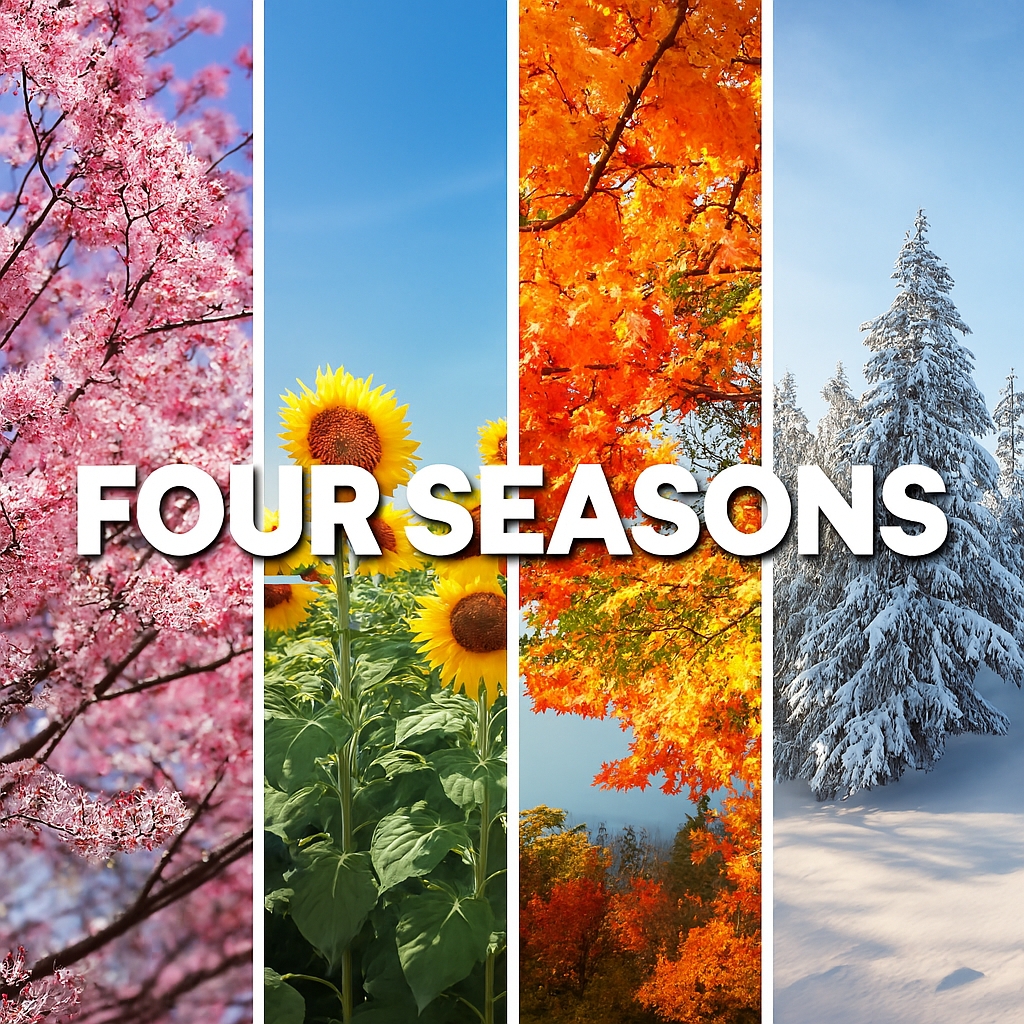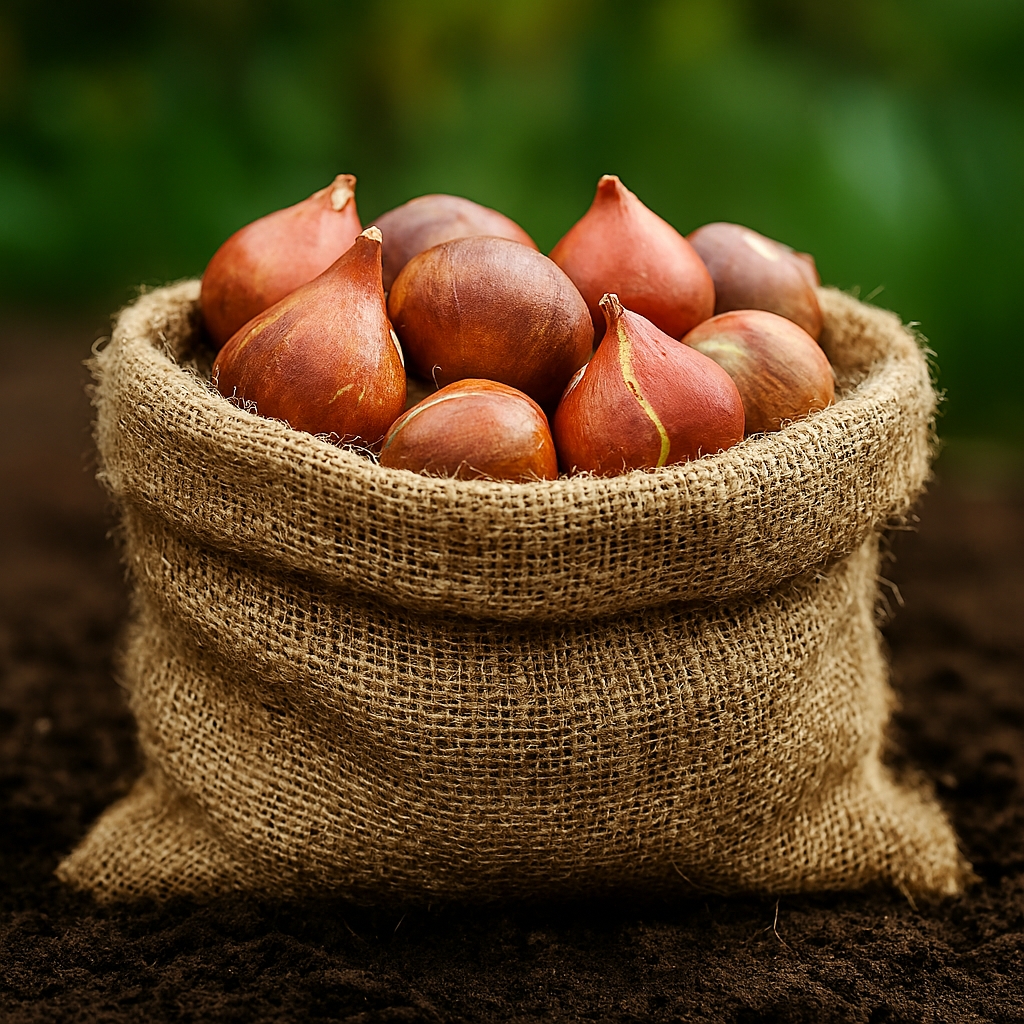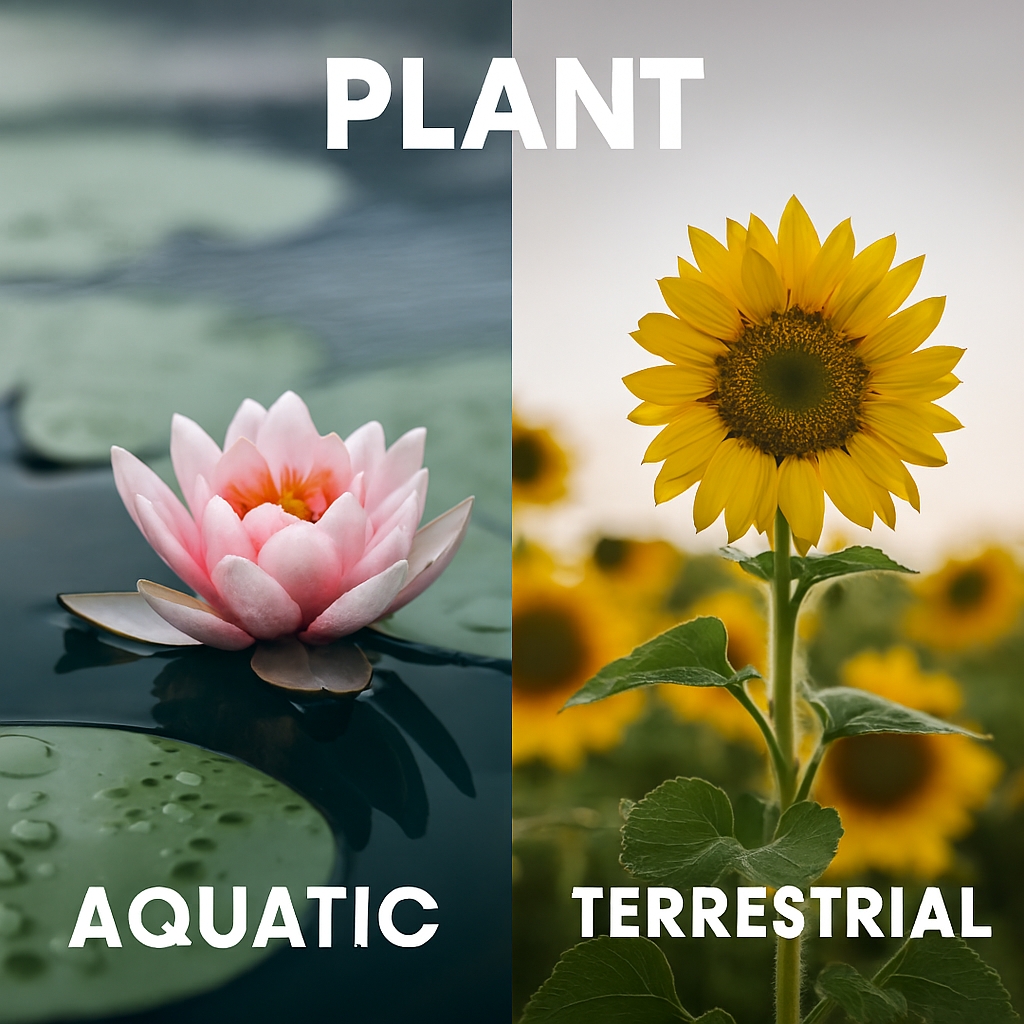Changing 4 Seasons
Environment And Ecology
Seasons are not just a backdrop to human life but a fundamental rhythm that shapes ecosystems, biodiversity, and environmental processes. Driven by Earth’s axial tilt and orbit around the Sun, seasonal changes influence temperature, precipitation, daylight, and ecological cycles. These shifts determine plant growth, animal migration, and even cultural traditions. Climate change, however, is altering these rhythms, creating cascading effects across ecosystems. Understanding the role of seasons in ecology is essential for grasping how life adapts and how disruptions threaten balance.

Seasonal Rhythms And Ecological Balance
Seasonal rhythms synchronize the life cycles of plants, animals, and microorganisms. Spring initiates growth, summer sustains productivity, autumn prepares for dormancy, and winter enforces rest. These cycles ensure food availability, regulate reproduction, and maintain biodiversity. When seasons shift, species struggle to adapt, leading to mismatches in food chains. Such disruptions ripple through ecosystems, affecting survival rates. Human activities like agriculture also rely on predictable seasons. Without stable rhythms, ecological and cultural systems face instability.
Table – Seasonal Ecological Functions
| Season | Primary Ecological Role | Example Impact |
|---|---|---|
| Spring | Renewal and growth | Plant germination and pollinator activity |
| Summer | Productivity peak | Crop maturation and animal breeding |
| Autumn | Preparation and migration | Leaf fall and bird migration |
| Winter | Dormancy and survival | Hibernation and reduced plant activity |
Climate Change And Seasonal Shifts
Climate change is lengthening growing seasons in some regions while shortening them in others. Vegetation growth periods have extended by nearly a month in parts of the Northern Hemisphere. This shift increases vulnerability to drought and disease. Species that rely on specific seasonal cues, such as migratory birds, face mismatches in timing. Trees are migrating to higher latitudes to find suitable climates. These changes disrupt ecological synchrony, threatening biodiversity. Human adaptation is possible through altered farming practices, but natural ecosystems lack such flexibility. The result is widespread ecological imbalance.
Key Points – Climate Change Effects
- Growing seasons lengthened in many regions
- Increased vulnerability to drought and disease
- Migratory species face timing mismatches
- Trees shift to higher latitudes
- Biodiversity threatened by disrupted synchrony
- Human agriculture adapts more easily than wild ecosystems
- Seasonal cues no longer reliable for reproduction
- Cascading effects across food chains
- Greater ecological instability
- Climate action determines future rhythms
Seasonal Changes And Water Systems
Water cycles are deeply tied to seasonal variation. Snowmelt in spring replenishes rivers, while summer evaporation reduces water availability. Autumn rains restore balance, and winter freezes lock water in ice. Disruptions in these cycles affect agriculture, hydropower, and ecosystems. Earlier snowmelt can cause floods, while reduced winter snowpack limits summer water supplies. Aquatic species depend on seasonal flows for breeding. Human water management systems must adapt to these changes. Without adjustment, shortages and ecological stress increase.
Table – Seasonal Water Cycle Impacts
| Season | Water Cycle Role | Ecological Impact |
|---|---|---|
| Spring | Snowmelt replenishment | River flow supports fish spawning |
| Summer | Evaporation peak | Reduced water for crops and wildlife |
| Autumn | Rainfall recovery | Wetlands restored for migratory birds |
| Winter | Ice storage | Aquatic dormancy and frozen habitats |
Seasonal Dynamics And Soil Health
Soil ecosystems respond directly to seasonal changes, influencing fertility, microbial activity, and nutrient cycling. In spring, warming temperatures stimulate microbial decomposition, releasing nutrients for plant growth. Summer heat accelerates evaporation, often stressing soil moisture levels. Autumn leaf fall enriches soil organic matter, while winter slows decomposition, preserving nutrients until warmer months. These cycles maintain soil health and agricultural productivity. Disruptions in seasonal timing can reduce fertility, alter microbial communities, and increase erosion risks. Farmers rely on predictable soil rhythms to plan planting and harvesting. Without stable seasonal cues, soil ecosystems lose resilience. This impacts food security and biodiversity. Soil health is thus a critical indicator of seasonal stability.
Table – Seasonal Soil Processes
| Season | Soil Process | Ecological Outcome |
|---|---|---|
| Spring | Microbial activation | Nutrient release for plant growth |
| Summer | Evaporation stress | Reduced soil moisture and crop yield |
| Autumn | Leaf litter input | Increased organic matter and fertility |
| Winter | Dormant decomposition | Nutrient preservation for spring |
Seasonal Influence On Animal Migration
Animal migration is one of the most visible ecological responses to seasonal change. Birds can recognise this time frame of change and start to migrate to warmer regions during winter, while fish like salmon start to return to rivers in spring. These movements ensure survival by aligning with food availability and breeding conditions. Seasonal cues such as daylight length and temperature trigger migrations.
Climate change disrupts these signals, causing mistimed arrivals. For example, birds may reach breeding grounds before insects emerge, reducing chick survival. Migration also supports ecosystem services, such as nutrient transfer across regions. Human interference, like habitat destruction, compounds seasonal disruptions. Protecting migratory pathways is essential for ecological balance. Seasonal migration highlights the interconnectedness of ecosystems. Without it, biodiversity declines rapidly.
Key Points – Migration And Seasons
- Birds migrate based on daylight and temperature
- Fish return to rivers during spring spawning
- Seasonal cues trigger survival strategies
- Climate change disrupts migration timing
- Mistimed arrivals reduce reproductive success
- Migration supports nutrient transfer across ecosystems
- Habitat destruction worsens seasonal disruptions
- Protecting pathways sustains biodiversity
- Migration reflects ecological interconnectedness
- Seasonal rhythms are vital for survival
Seasonal Cycles And Plant Phenology
Plant phenology refers to the timing of biological events such as flowering, leafing, and fruiting. These events are tightly linked to seasonal changes. Spring triggers flowering, summer sustains fruiting, autumn initiates leaf fall, and winter enforces dormancy. Phenological shifts affect pollination, seed dispersal, and food availability. Climate change causes earlier flowering, which may not align with pollinator activity. This mismatch reduces reproductive success and threatens plant populations. Phenology also influences agriculture, determining crop yields and harvest times. Monitoring phenological changes helps scientists track climate impacts. Seasonal cycles thus act as natural calendars for plant life. Disruptions in these cycles destabilize ecosystems. Phenology is a key measure of ecological resilience.
Table – Plant Phenology Across Seasons
| Season | Phenological Event | Ecological Impact |
|---|---|---|
| Spring | Flowering | Pollinator activity and reproduction |
| Summer | Fruiting | Seed dispersal and food supply |
| Autumn | Leaf fall | Soil enrichment and dormancy preparation |
| Winter | Dormancy | Energy conservation and survival |

Seasonal Variations And Human Agriculture
Human agriculture depends heavily on seasonal cycles. Planting, growing, and harvesting are aligned with predictable weather patterns. Spring provides optimal conditions for sowing, while summer ensures crop maturation. Autumn is harvest season, and winter often requires storage and preservation. Seasonal disruptions threaten food security by altering yields. For example, droughts during summer reduce productivity, while floods in spring damage seedlings. Farmers adapt through irrigation, crop rotation, and technology. However, natural ecosystems lack such flexibility. Seasonal agriculture also shapes cultural traditions, such as harvest festivals. Climate change challenges these traditions by destabilizing rhythms. Protecting seasonal balance is vital for sustainable farming. Agriculture demonstrates humanity’s reliance on ecological cycles.
Key Points – Agriculture And Seasons
- Planting aligned with spring conditions
- Summer ensures crop maturation
- Autumn marks harvest season
- Winter requires storage and preservation
- Seasonal disruptions threaten food security
- Droughts reduce productivity
- Floods damage seedlings
- Farmers adapt with technology
- Cultural traditions tied to agriculture
- Climate change destabilizes rhythms
Seasonal Impacts On Marine Ecosystems
Marine ecosystems also respond to seasonal changes. Ocean currents, temperature, and nutrient availability vary across seasons. Spring and summer often bring plankton blooms, supporting fish populations. Autumn shifts currents, redistributing nutrients, while winter reduces productivity. Seasonal cycles regulate marine food chains. Disruptions, such as warming oceans, alter plankton timing. This affects fish, seabirds, and marine mammals. Coral reefs also depend on seasonal stability for spawning. Human activities like overfishing compound seasonal stress. Marine ecosystems highlight the global reach of seasonal rhythms. Protecting oceans requires understanding these cycles. Without seasonal balance, marine biodiversity declines. Oceans are vital to planetary health, making seasonal stability critical.
Table – Marine Seasonal Processes
| Season | Marine Process | Ecological Impact |
|---|---|---|
| Spring | Plankton bloom | Fish population growth |
| Summer | Nutrient peak | Marine productivity |
| Autumn | Current shifts | Redistribution of nutrients |
| Winter | Reduced productivity | Dormancy in marine food chains |
Seasonal Changes And Forest Ecosystems
Forests are deeply influenced by seasonal rhythms. Spring initiates leaf growth, summer sustains canopy productivity, autumn triggers leaf fall, and winter enforces dormancy. These cycles regulate carbon storage and oxygen production. Seasonal changes also influence forest wildlife, from insect emergence to mammal hibernation. Climate change alters forest rhythms, causing earlier leafing and longer growing seasons. This increases vulnerability to pests and disease. Forest fires, often linked to summer droughts, disrupt seasonal balance. Forest ecosystems are crucial for biodiversity and climate regulation. Protecting seasonal rhythms ensures forest resilience. Human reliance on forests for resources highlights their importance. Seasonal changes are thus central to forest ecology.
Key Points – Forest Ecology And Seasons
- Spring initiates leaf growth
- Summer sustains canopy productivity
- Autumn triggers leaf fall
- Winter enforces dormancy
- Carbon storage regulated by seasons
- Wildlife cycles depend on forest rhythms
- Climate change alters timing
- Longer growing seasons increase vulnerability
- Forest fires disrupt balance
- Forests vital for biodiversity
Seasonal Influence On Wetlands
Wetlands depend on seasonal water cycles for survival. Spring floods replenish wetlands, summer evaporation reduces water levels, autumn rains restore balance, and winter freezes stabilize ecosystems. These cycles support migratory birds, amphibians, and aquatic plants. Seasonal disruptions threaten wetland biodiversity. Reduced flooding limits breeding grounds, while prolonged droughts dry habitats. Wetlands also filter water and store carbon. Climate change reduces seasonal predictability, weakening these functions. Human drainage and development compound seasonal stress. Protecting wetlands requires maintaining seasonal rhythms. Wetlands highlight the link between water cycles and biodiversity. Without seasonal balance, ecosystems collapse. Wetlands are vital for ecological resilience.
Table – Wetland Seasonal Functions
| Season | Wetland Role | Ecological Impact |
|---|---|---|
| Spring | Flood replenishment | Breeding grounds for amphibians |
| Summer | Evaporation stress | Reduced habitat for aquatic species |
| Autumn | Rainfall recovery | Migratory bird support |
| Winter | Freeze stabilization | Dormancy and survival |
Seasonal Cycles And Human Culture
Human culture has always been shaped by seasonal rhythms. Festivals, rituals, and traditions align with planting, harvest, and migration. Spring celebrations mark renewal, summer festivals honor productivity, autumn rituals celebrate harvest, and winter traditions emphasize survival. Seasonal changes influence art, literature, and religion. Climate change threatens these cultural rhythms, destabilizing traditions. Communities adapt by shifting celebrations, but ecological meaning is lost. Seasonal culture reflects humanity’s connection to nature. Protecting rhythms preserves cultural heritage. Without seasonal balance, traditions lose relevance. Culture and ecology are intertwined through seasons. This highlights the broader meaning of seasonal cycles. Human identity is deeply tied to ecological rhythms.
Key Points – Culture And Seasons
- Festivals aligned with planting and harvest
- Spring marks renewal
- Summer honors productivity
- Autumn celebrates harvest
- Winter emphasizes survival
- Seasonal changes influence art and religion
- Climate change destabilizes traditions
- Communities adapt celebrations
- Ecological meaning is lost
- Human identity tied to rhythms
Seasonal Cycles And Biodiversity
Biodiversity thrives on seasonal variation. Different species adapt to specific seasonal niches. Spring supports pollinators, summer sustains predators, autumn aids migration, and winter enforces survival strategies. Seasonal diversity ensures ecological resilience. Climate change reduces biodiversity by disrupting niches. Species unable to adapt face extinction. Biodiversity loss destabilizes ecosystems, reducing services like pollination and water purification. Protecting seasonal rhythms sustains biodiversity. Human activities must align with ecological cycles. Biodiversity reflects the health of seasonal systems. Without it, ecosystems collapse. Seasons are thus critical for sustaining life. Biodiversity highlights the ecological meaning of seasonal change.
Table – Seasonal Biodiversity Roles
| Season | Biodiversity Role | Ecological Impact |
|---|---|---|
| Spring | Pollinator activity | Plant reproduction |
| Summer | Predator sustenance | Food chain stability |
| Autumn | Migration support | Species survival |
| Winter | Survival strategies | Ecosystem resilience |
Seasonal Variations And Desert Ecosystems
Desert ecosystems are uniquely shaped by seasonal extremes. Spring often brings brief bursts of rainfall, triggering wildflower blooms and temporary water sources. Summer intensifies heat, pushing species into nocturnal activity to conserve energy. Autumn may bring cooler nights, allowing plants to recover from summer stress. Winter provides rare opportunities for growth when temperatures drop. These cycles sustain desert biodiversity despite harsh conditions. Climate change disrupts rainfall timing, reducing opportunities for regeneration. Desert species are highly specialized, making them vulnerable to seasonal shifts. Human water extraction compounds stress on fragile rhythms. Protecting seasonal balance is vital for desert survival. Deserts demonstrate resilience but remain sensitive to ecological disruption.
Table – Desert Seasonal Adaptations
| Season | Adaptation | Ecological Impact |
|---|---|---|
| Spring | Rain-triggered blooms | Temporary food and pollinator support |
| Summer | Nocturnal activity | Energy conservation and survival |
| Autumn | Cooler nights | Plant recovery and animal activity |
| Winter | Growth opportunities | Species regeneration and resilience |
Seasonal Cycles And Polar Regions
Polar regions experience extreme seasonal contrasts. Summer brings continuous daylight, fueling productivity and ice melt. Winter enforces darkness and freezing, limiting activity. Seasonal cycles regulate ice cover, ocean currents, and wildlife survival. Polar bears, seals, and penguins depend on seasonal ice for hunting and breeding. Climate change accelerates ice loss, disrupting these rhythms. Earlier ice melt reduces hunting grounds, threatening survival. Seasonal shifts also alter global ocean circulation, impacting distant ecosystems. Human reliance on polar stability for climate regulation is immense. Protecting polar rhythms is critical for planetary health. Polar regions highlight the global significance of seasonal cycles.
Key Points – Polar Seasons
- Summer brings continuous daylight
- Winter enforces darkness and freezing
- Ice cover regulates ecosystems
- Polar wildlife depends on seasonal ice
- Climate change accelerates ice loss
- Hunting grounds reduced for predators
- Ocean circulation altered globally
- Polar rhythms critical for climate regulation
- Human reliance immense
- Polar regions highlight global significance
Seasonal Influence On Grasslands
Grasslands thrive on seasonal rainfall and temperature cycles. Spring rains trigger rapid plant growth, supporting herbivores. Summer sustains productivity but risks drought. Autumn prepares ecosystems for dormancy, while winter slows activity. Seasonal cycles regulate grazing patterns and predator-prey dynamics. Climate change alters rainfall timing, destabilizing grassland rhythms. Prolonged droughts reduce biodiversity, while floods damage soil. Grasslands also store carbon, making seasonal stability vital. Human agriculture often overlaps with grassland ecosystems, increasing stress. Protecting seasonal cycles ensures grassland resilience. Grasslands highlight the balance between productivity and vulnerability. Seasonal rhythms are essential for their survival.
Table – Grassland Seasonal Roles
| Season | Grassland Role | Ecological Impact |
|---|---|---|
| Spring | Rain-triggered growth | Herbivore sustenance |
| Summer | Productivity peak | Predator-prey balance |
| Autumn | Dormancy preparation | Soil enrichment |
| Winter | Slowed activity | Energy conservation |

Seasonal Cycles And Urban Environments
Urban environments also experience seasonal rhythms. Temperature changes influence energy demand, water use, and human health. Spring increases outdoor activity, summer raises cooling needs, autumn reduces energy demand, and winter increases heating. Seasonal cycles affect urban biodiversity, such as bird migration and plant growth. Climate change intensifies urban heat islands, disrupting rhythms. Seasonal disruptions increase health risks, such as heatwaves and cold snaps. Urban planning must adapt to seasonal variability. Green spaces help regulate seasonal impacts. Cities highlight the human dimension of seasonal cycles. Protecting rhythms ensures sustainable urban living. Urban environments demonstrate the ecological reach of seasons.
Key Points – Urban Seasons
- Temperature changes influence energy demand
- Spring increases outdoor activity
- Summer raises cooling needs
- Autumn reduces energy demand
- Winter increases heating
- Urban biodiversity shaped by seasons
- Climate change intensifies heat islands
- Seasonal disruptions increase health risks
- Urban planning must adapt
- Green spaces regulate impacts
Seasonal Cycles And Mountain Ecosystems
Mountain ecosystems are highly sensitive to seasonal changes. Spring snowmelt replenishes rivers, summer supports alpine growth, autumn triggers migration, and winter enforces dormancy. Seasonal cycles regulate water supply for downstream regions. Climate change alters snowmelt timing, causing floods or shortages. Mountain species depend on seasonal cues for survival. Earlier snowmelt disrupts breeding cycles. Human reliance on mountain water highlights their importance. Seasonal rhythms sustain both ecosystems and human communities. Protecting mountain cycles ensures resilience. Mountains demonstrate the interconnectedness of seasonal systems. Their stability is vital for biodiversity and human survival.
Table – Mountain Seasonal Processes
| Season | Mountain Role | Ecological Impact |
|---|---|---|
| Spring | Snowmelt replenishment | River flow supports ecosystems |
| Summer | Alpine growth | Biodiversity peak |
| Autumn | Migration support | Species survival |
| Winter | Dormancy | Energy conservation |
Seasonal Cycles And Coastal Ecosystems
Coastal ecosystems respond to seasonal tides, storms, and temperature changes. Spring and summer often bring productivity peaks, supporting fisheries. Autumn storms reshape coastlines, while winter enforces dormancy. Seasonal cycles regulate nutrient flows and habitat stability. Climate change intensifies storms, disrupting rhythms. Rising sea levels alter seasonal dynamics. Coastal species depend on predictable cycles for breeding. Human development compounds seasonal stress. Protecting coastal rhythms ensures biodiversity and resilience. Coastal ecosystems highlight the link between land and sea. Seasonal balance is critical for their survival. Without it, ecosystems collapse.
Key Points – Coastal Seasons
- Tides and storms shape ecosystems
- Spring and summer productivity peaks
- Autumn storms reshape coastlines
- Winter enforces dormancy
- Nutrient flows regulated by seasons
- Climate change intensifies storms
- Rising sea levels alter dynamics
- Species depend on predictable cycles
- Human development compounds stress
- Coastal balance critical for survival
Seasonal Cycles And Freshwater Ecosystems
Freshwater ecosystems rely on seasonal flows. Spring floods replenish rivers, summer evaporation reduces water, autumn rains restore balance, and winter freezes stabilize habitats. Seasonal cycles regulate fish breeding and aquatic plant growth. Climate change alters flow timing, disrupting ecosystems. Reduced flooding limits breeding grounds, while droughts dry habitats. Freshwater ecosystems also support human water supply. Protecting seasonal rhythms ensures resilience. Human interference compounds stress through dams and pollution. Freshwater systems highlight the importance of seasonal balance. Without it, biodiversity declines. Seasonal cycles are vital for freshwater survival.
Table – Freshwater Seasonal Roles
| Season | Freshwater Role | Ecological Impact |
|---|---|---|
| Spring | Flood replenishment | Fish breeding support |
| Summer | Evaporation stress | Reduced water availability |
| Autumn | Rainfall recovery | Aquatic plant growth |
| Winter | Freeze stabilization | Dormancy and survival |
Seasonal Cycles And Global Ecology
Global ecology is shaped by interconnected seasonal rhythms. Polar ice regulates ocean currents, deserts respond to rainfall, forests store carbon, and oceans sustain productivity. These cycles interact across regions. Climate change disrupts global synchrony, destabilizing ecosystems. Seasonal shifts in one region affect distant systems. For example, polar ice melt alters global circulation. Protecting seasonal balance is essential for planetary health. Human activities must align with ecological rhythms. Global ecology reflects the interconnectedness of seasons. Without balance, ecosystems collapse worldwide. Seasons are thus critical for sustaining life. Global rhythms highlight the meaning of seasonal change.
Key Points – Global Ecology And Seasons
- Polar ice regulates currents
- Deserts respond to rainfall
- Forests store carbon
- Oceans sustain productivity
- Cycles interact globally
- Climate change disrupts synchrony
- Shifts affect distant systems
- Protecting balance essential
- Human activities must align
- Seasons sustain life globally
Seasonal Cycles And Savannah Ecosystems
Savannah ecosystems are defined by alternating wet and dry seasons. Rainfall during the wet season triggers rapid plant growth, supporting herbivores and predators. The dry season reduces water availability, forcing animals to migrate or adapt. Seasonal cycles regulate fire regimes, which maintain grassland balance by preventing tree dominance. Climate change alters rainfall timing, destabilizing savannah rhythms. Prolonged droughts reduce biodiversity, while intense rains cause flooding. Human agriculture overlaps with savannah ecosystems, increasing stress. Protecting seasonal balance ensures savannah resilience. Savannahs highlight the delicate balance between productivity and vulnerability. Seasonal rhythms are essential for their survival.
Table – Savannah Seasonal Roles
| Season | Savannah Role | Ecological Impact |
|---|---|---|
| Wet | Rain-triggered growth | Herbivore sustenance and predator support |
| Dry | Water scarcity | Migration and adaptation |
| Transition | Fire regimes | Grassland balance and biodiversity |
| Annual cycle | Alternating extremes | Ecological resilience and vulnerability |
Seasonal Cycles And River Ecosystems
River ecosystems rely on seasonal flows for survival. Spring floods replenish habitats, summer evaporation reduces water, autumn rains restore balance, and winter freezes stabilize ecosystems. Seasonal cycles regulate fish breeding and aquatic plant growth. Climate change alters flow timing, disrupting ecosystems. Reduced flooding limits breeding grounds, while droughts dry habitats. Rivers also support human water supply and agriculture. Protecting seasonal rhythms ensures resilience. Human interference compounds stress through dams and pollution. River systems highlight the importance of seasonal balance. Without it, biodiversity declines. Seasonal cycles are vital for river survival.
Key Points – River Ecology And Seasons
- Spring floods replenish habitats
- Summer evaporation reduces water availability
- Autumn rains restore balance
- Winter freezes stabilize ecosystems
- Fish breeding regulated by seasonal flows
- Aquatic plant growth depends on rhythms
- Climate change alters timing
- Reduced flooding limits breeding grounds
- Human interference compounds stress
- Seasonal cycles vital for survival
Seasonal Cycles And Agricultural Landscapes
Agricultural landscapes are deeply tied to seasonal rhythms. Spring provides optimal conditions for sowing, summer ensures crop maturation, autumn marks harvest, and winter requires storage. Seasonal disruptions threaten food security by altering yields. Droughts during summer reduce productivity, while floods in spring damage seedlings. Farmers adapt through irrigation, crop rotation, and technology. However, natural ecosystems lack such flexibility. Seasonal agriculture also shapes cultural traditions, such as harvest festivals. Climate change challenges these traditions by destabilizing rhythms. Protecting seasonal balance is vital for sustainable farming. Agriculture demonstrates humanity’s reliance on ecological cycles. Without stable seasons, food systems collapse.
Table – Agricultural Seasonal Roles
| Season | Agricultural Role | Impact |
|---|---|---|
| Spring | Sowing | Crop establishment |
| Summer | Maturation | Productivity peak |
| Autumn | Harvest | Food supply secured |
| Winter | Storage | Preservation and survival |
Seasonal Cycles And Human Health
Human health is influenced by seasonal changes. Spring increases outdoor activity, summer raises risks of heat stress, autumn reduces energy demand, and winter increases cold-related illnesses. Seasonal cycles also affect mental health, with daylight influencing mood. Climate change intensifies seasonal extremes, increasing health risks. Heatwaves cause dehydration, while cold snaps increase respiratory illness. Seasonal rhythms regulate disease vectors, such as mosquitoes. Disruptions alter disease spread, threatening public health. Urban planning must adapt to seasonal variability. Protecting rhythms ensures sustainable living. Human health demonstrates the ecological reach of seasons. Without balance, communities face instability.
Key Points – Health And Seasons
- Spring increases outdoor activity
- Summer raises heat stress risks
- Autumn reduces energy demand
- Winter increases cold-related illness
- Daylight influences mood
- Climate change intensifies extremes
- Heatwaves cause dehydration
- Cold snaps increase respiratory illness
- Disease vectors regulated by seasons
- Public health depends on rhythms

Seasonal Cycles And Ecosystem Services
Ecosystem services are regulated by seasonal rhythms. Spring supports pollination, summer sustains productivity, autumn enriches soil, and winter conserves energy. These services underpin human survival. Climate change disrupts seasonal timing, reducing ecosystem benefits. Pollination mismatches threaten food supply, while soil fertility declines. Seasonal cycles also regulate water purification and carbon storage. Protecting rhythms ensures ecosystem resilience. Human reliance on these services highlights their importance. Without seasonal balance, ecosystems collapse. Ecosystem services demonstrate the meaning of seasonal change. They connect ecology to human well-being. Seasons are thus critical for sustaining life.
Table – Seasonal Ecosystem Services
| Season | Service | Impact |
|---|---|---|
| Spring | Pollination | Food supply supported |
| Summer | Productivity | Biodiversity sustained |
| Autumn | Soil enrichment | Fertility increased |
| Winter | Energy conservation | Survival ensured |
Seasonal Cycles And Global Food Security
Global food security depends on seasonal rhythms. Planting, growing, and harvesting align with predictable cycles. Climate change disrupts these rhythms, threatening yields. Droughts reduce productivity, floods damage crops, and heatwaves stress livestock. Seasonal disruptions destabilize global food systems. Farmers adapt through technology, but ecosystems lack flexibility. Seasonal agriculture also shapes trade and economy. Protecting rhythms ensures food security. Human reliance on seasonal cycles highlights their importance. Without balance, hunger increases worldwide. Food security demonstrates the global meaning of seasonal change. Seasons are critical for sustaining humanity. Their disruption threatens survival.
Key Points – Food Security And Seasons
- Planting aligned with spring conditions
- Growing sustained by summer productivity
- Harvest secured in autumn
- Storage required in winter
- Climate change disrupts rhythms
- Droughts reduce productivity
- Floods damage crops
- Heatwaves stress livestock
- Trade shaped by agriculture
- Food security depends on balance
Seasonal Cycles And Renewable Energy
Renewable energy systems depend on seasonal rhythms. Solar power peaks in summer, wind energy varies across seasons, and hydropower relies on snowmelt and rainfall. Seasonal cycles regulate energy supply. Climate change disrupts these rhythms, reducing reliability. Droughts limit hydropower, while altered wind patterns affect turbines. Seasonal predictability is vital for energy planning. Protecting rhythms ensures sustainable energy. Human reliance on renewable systems highlights their importance. Without balance, energy security declines. Renewable energy demonstrates the ecological meaning of seasonal change. Seasons connect environment to technology. Their disruption threatens sustainability.
Table – Seasonal Renewable Energy Roles
| Season | Energy Role | Impact |
|---|---|---|
| Spring | Snowmelt hydropower | Energy supply increased |
| Summer | Solar peak | Productivity maximized |
| Autumn | Wind variability | Energy distribution |
| Winter | Reduced solar | Reliance on other sources |
Seasonal Cycles And Tourism
Tourism is shaped by seasonal rhythms. Spring attracts nature enthusiasts, summer supports beach tourism, autumn offers cultural festivals, and winter sustains ski resorts. Seasonal cycles regulate tourism demand. Climate change disrupts these rhythms, reducing reliability. Heatwaves deter summer tourism, while reduced snowfall threatens winter resorts. Seasonal predictability is vital for tourism planning. Protecting rhythms ensures sustainable tourism. Human reliance on seasonal cycles highlights their importance. Without balance, economies decline. Tourism demonstrates the cultural meaning of seasonal change. Seasons connect environment to human activity. Their disruption threatens livelihoods.
Key Points – Tourism And Seasons
- Spring attracts nature enthusiasts
- Summer supports beach tourism
- Autumn offers cultural festivals
- Winter sustains ski resorts
- Climate change disrupts rhythms
- Heatwaves deter tourism
- Reduced snowfall threatens resorts
- Predictability vital for planning
- Tourism connects environment to culture
- Livelihoods depend on balance
Seasonal Cycles And Global Climate Regulation
Global climate regulation depends on seasonal rhythms. Polar ice regulates ocean currents, forests store carbon, and oceans sustain productivity. Seasonal cycles interact across regions. Climate change disrupts global synchrony, destabilizing ecosystems. Seasonal shifts in one region affect distant systems. For example, polar ice melt alters global circulation. Protecting seasonal balance is essential for planetary health. Human activities must align with ecological rhythms. Global climate regulation reflects the interconnectedness of seasons. Without balance, ecosystems collapse worldwide. Seasons are thus critical for sustaining life. Global rhythms highlight the meaning of seasonal change.
Table – Seasonal Climate Regulation Roles
| Season | Climate Role | Impact |
|---|---|---|
| Spring | Carbon uptake | Biodiversity supported |
| Summer | Productivity peak | Climate stability |
| Autumn | Soil enrichment | Carbon storage |
| Winter | Ice regulation | Global circulation |
Final Thoughts
Seasons are not mere divisions of time but ecological regulators that sustain biodiversity, water systems, forests, deserts, oceans, and human culture. Their rhythms underpin survival strategies across ecosystems and societies. Climate change disrupts these cycles, creating mismatches and ecological stress. Protecting seasonal balance is essential for resilience and sustainability. From soil fertility to polar ice, seasonal rhythms shape life on Earth. Human adaptation must align with ecological cycles to safeguard the future. Seasons embody the interconnectedness of global ecology. Their meaning extends beyond environment into culture and identity. Understanding and protecting seasonal rhythms is vital for planetary health.
Conclusion
Seasons are more than calendar divisions – they are ecological regulators that sustain life. From plant growth to animal migration, seasonal rhythms underpin biodiversity and environmental stability. Climate change is disrupting these cycles, creating mismatches and ecological stress. Water systems, food chains, and cultural traditions all depend on predictable seasonal patterns. Protecting seasonal balance requires climate action and ecological awareness. By understanding the meaning of seasons, humanity can better safeguard ecosystems and adapt responsibly.
Join The Discussion
How do you see seasonal changes affecting your local environment and community life?
#Seasons #Ecology #Environment #ClimateChange #Biodiversity #Sustainability #NatureBalance #Ecosystems













Leave a Reply